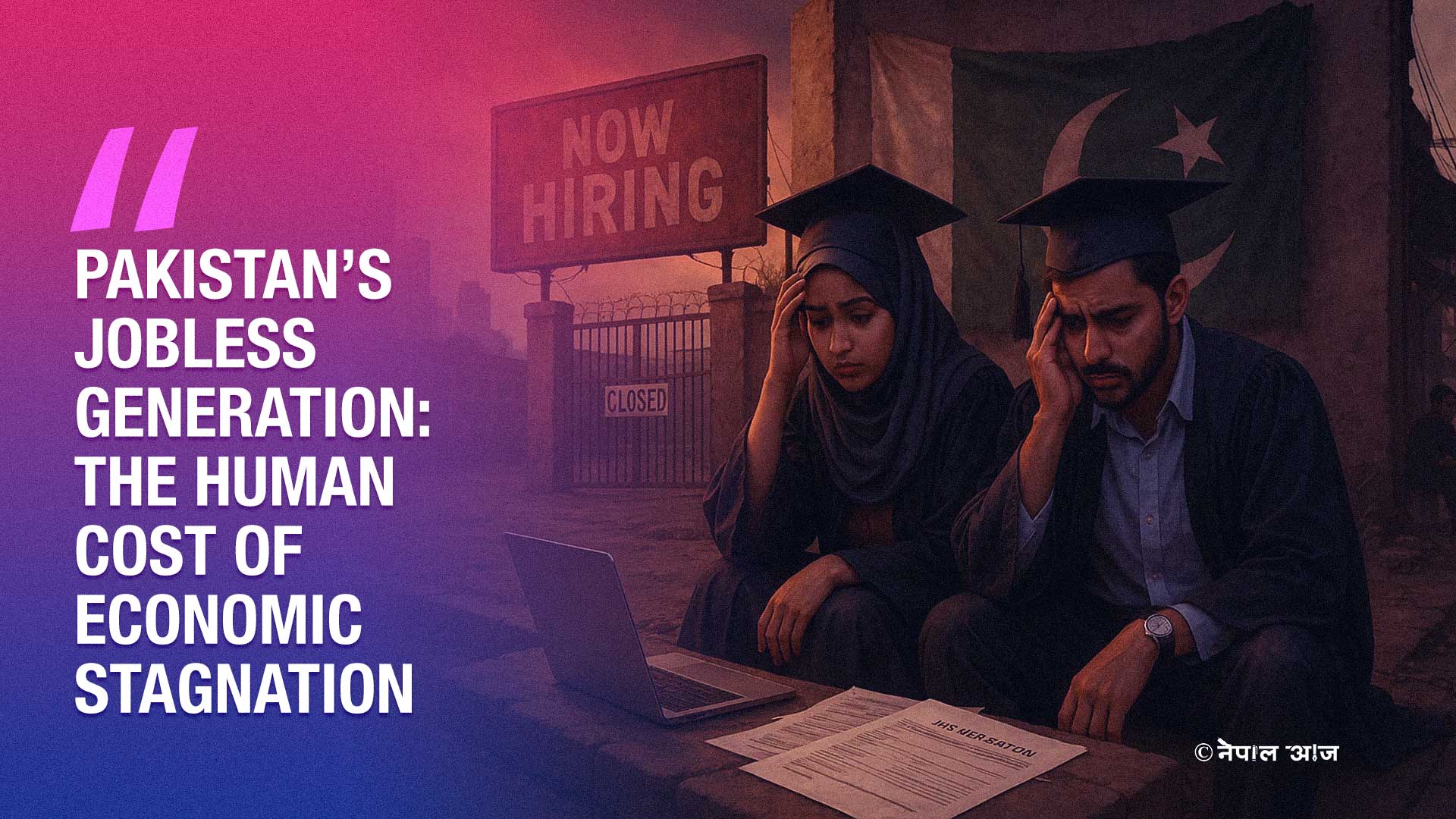The Human Cost of Unemployment in Pakistan

Pakistan, the world’s fifth most populous country with over 255 million people, stands at a critical juncture in its socio-economic development. Among its most pressing challenges is unemployment, particularly youth unemployment, which has intensified in recent years and threatens to undermine the country’s stability, growth, and future prospects.
The overall unemployment rate in Pakistan has seen a troubling upward trend, rising from 5.41% in 2023 to 5.47% in 2024, and forecasted to reach 8% in 2025. This increase is not merely statistical, it reflects a deepening crisis that disproportionately affects the youth, especially those aged 15 to 35. According to the 2025–26 budget, the national unemployment rate stands at 6.3%, but youth unemployment far exceeds this figure, with estimates suggesting rates above 10% in both urban and rural areas. Approximately 32.5% of young people aged 15-29 are considered NEET (Not in Education, Employment, or Training), a rate that is significantly higher for women (55%) compared to men (11%).
Graduate unemployment is becoming a serious challenge as it is almost three times the average unemployment rate in the country. There are four major reasons for this trend; first a high disparity between the education offered and the need of the economy to accommodate these graduates. Second, a weak university-industry linkage, means that graduates being produced are not what is being demanded by the industry. Third, the increased number of people looking for jobs increases the labor force. Finally, the shrinking state of the economy; and macroeconomic imbalances.
In 2021, the rate reached 16.1%, with engineers and computer science graduates among the hardest hit. Despite a surge in higher education enrollment, over 30% of graduates remain jobless, revealing a disconnect between academic training and market needs.
Pakistan’s demographic profile is both a potential asset and a looming liability. With 64% of the population under the age of 30, the country is experiencing a youth bulge that could fuel economic growth, if harnessed effectively. However, the labor market has failed to absorb this influx. Pakistan needs to create 1.5 million jobs annually to meet demand, yet this goal remains elusive amid economic stagnation and a population growing by 5 million each year.
The gradual increase in labor force participation has added pressure on an already strained job market. Unlike other Asian economies such as China, Pakistan’s structural transition from low to high-productivity sectors has been sluggish, limiting opportunities for upward mobility.
One of the least understood yet most significant contributors to unemployment in Pakistan is the organization and quality of its education system. While the number of institutions and students has grown, the relevance and rigor of academic programs have not kept pace. The lack of integration of practical skills into curricula leaves graduates ill-prepared for the contemporary job market.
In the Global Innovation Index (GII) 2025, Pakistan ranks 99th out of 139 economies, reflecting poor overall innovation performance. The GII evaluates countries based on approximately 80 indicators, categorized into innovation inputs and outputs. Notably, Pakistan's position in innovation inputs has declined to 124th this year, lower than its ranking in the previous edition, highlighting persistent challenges in areas such as infrastructure, education, and institutional support for innovation.
This disconnect is especially pronounced in technical fields. Despite the demand for skilled professionals, graduates in engineering and computer science face high unemployment due to outdated syllabi, inadequate training facilities, and poor industry-academia linkages.
Pakistan’s unemployment crisis is deeply intertwined with a range of structural and macroeconomic factors that continue to hinder sustainable job creation. At the heart of the issue lies persistent GDP stagnation, which restricts both public and private sector investment, thereby limiting the expansion of employment opportunities. Trade imbalances and an overreliance on imports further weaken domestic industries, reducing their capacity to absorb labor and stimulate growth. Inflation compounds the problem by eroding consumer purchasing power, dampening demand, and discouraging business expansion. While Technical Cooperation Grants (TCGs) offer some support, they remain insufficient to address the systemic and long-term challenges facing Pakistan’s labor market.
The energy crisis has forced many industries to shut down, leading to job losses and a slowdown in industrial development. Political instability further exacerbates the situation, deterring foreign investment and disrupting economic planning.
Furthermore, the unemployment landscape in Pakistan is shaped by a stark urban-rural divide. Urban centers, though more developed, suffer from intense competition for limited jobs, especially among educated youth. In contrast, rural areas rely heavily on agriculture, where employment is seasonal, low-paid, and vulnerable to climate shocks.
This divide not only affects economic outcomes but also contributes to social fragmentation. Rural youth often migrate to cities in search of better opportunities, only to encounter overcrowded job markets and limited prospects.
Gender disparities in youth unemployment present a stark and troubling dimension of Pakistan’s labor market crisis. Of the total unemployed youth population, more than half (51%) are female, while only 16% are male, despite many of the latter holding professional degrees. This gender gap is closely linked to Pakistan’s low female labor force participation rate (LFPR), which hovers around 19.6%, in stark contrast to the male LFPR of 69.5%.
A substantial proportion of educated women fall into the NEET (Not in Education, Employment, or Training) category, largely due to entrenched cultural norms and societal expectations that discourage or restrict women’s economic engagement. The divide is particularly evident in technical fields: a study of engineering graduates found that nearly 70% of female engineers were unemployed, with many never entering the workforce at all. These figures underscore the urgent need for gender-sensitive labor policies and structural reforms to unlock the untapped potential of Pakistan’s educated female youth.
Youth unemployment has profound implications beyond economics, it is reshaping Pakistan’s political and social fabric. Disillusioned by the lack of opportunities, many young people have disengaged from traditional politics and turned to alternative forms of expression. Since 2020, political mobilization among unemployed youth has taken on increasingly volatile dimensions.
Digital activism, populist movements, and even extremist ideologies have gained traction as outlets for frustration. Protests against inflation, corruption, and authoritarian governance have surged, often organized spontaneously through social media platforms. These movements bypass traditional party structures and reflect a growing demand for structural reforms.
The rise in youth-led protests and political activism poses challenges to Pakistan’s stability. While such mobilization can be a force for positive change, it also risks deepening polarization and undermining social cohesion in an already volatile environment.
Recognizing the gravity of the unemployment crisis, the government has launched initiatives such as the KamyabJawan Program and the Ehsaas Program. The former aims to provide vocational training and financial support to young entrepreneurs, while the latter focuses on poverty alleviation through social welfare schemes. However, these programs have faced significant implementation challenges. Bureaucratic inefficiencies, corruption, and lack of coordination among government agencies in Pakistan continue to hinder the chances of addressing unemployment meaningfully.




![From Kathmandu to the World: How Excel Students Are Winning Big [Admission Open]](https://nepalaaja.com/img/70194/medium/excel-college-info-eng-nep-2342.jpg)
